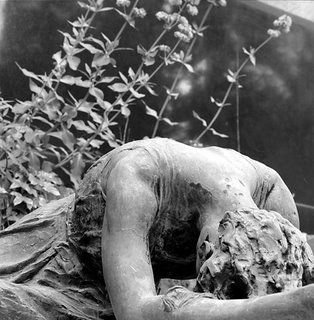DEATH AND THE MAIDEN V - Romantic Statuary

Statuary expressing the female form brings together powerful forces of death and sensuality, the eternal link between Thanatos and Eros. This expression reached a high level during the romantic era of the early nineteenth century. In Romantic art, death became a metaphor not of loss, fear and horror but of love and desire.
For the Romantics, death was an important theme. For them death was experienced as exquisite emotion and the ultimate expression of love.
"To die loving you is better than life itself," wrote Alferd de Musset.
The Romantic era was a period of "beautiful death" in which death was perceived as a refuge, a release, a reward and a rebirth. Death was associated with rebirth, conception, birth and sexual expression. The transition from death to eternal life was seen as a rebirth and came to be symbolized by a release of sensual pleasure expressed by the "petite death".
It is no accident that the expression of morning by the women in many of the works is indistinguishable from sexual ecstasy.
Cemeteries are places of infinite optimism where life everlasting takes precedence over death, loss and mortality. The focus is turned from the temporal past to: salvation, rebirth and everlasting life. Memorial art functions as both tribute and hope with these sensuous figures embracing this powerful duality. It is interesting to observe that the cemetery is the ideal venue for art dedicated to exploring this important duality. In one regard, these are surrogate mourners depicting how great the loss is and how deeply the deceased is missed. Their idealized beauty is spiritual: representing innocence, birth, rebirth, renewal, purity, fertility, commitment and passion. The greater their beauty the greater and more profound the loss and the greater the promise of eternal life. However in their dual role these women also serve as escorts in the journey ahead. As surrogate companions they stand post, watching over the deceased. Forever present and forever young, they communicate the hope for eternal youth, beauty and vitality in the life to come.


<< Home